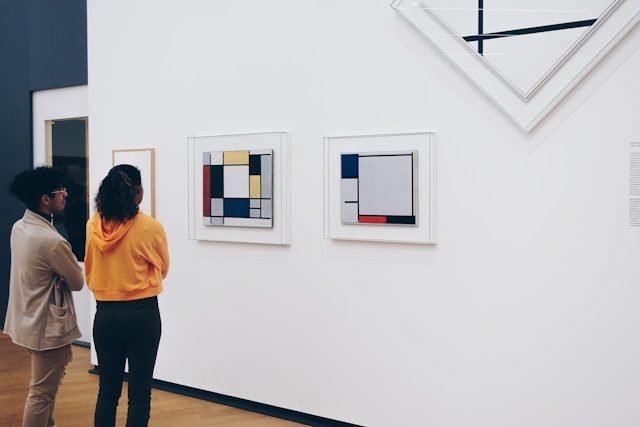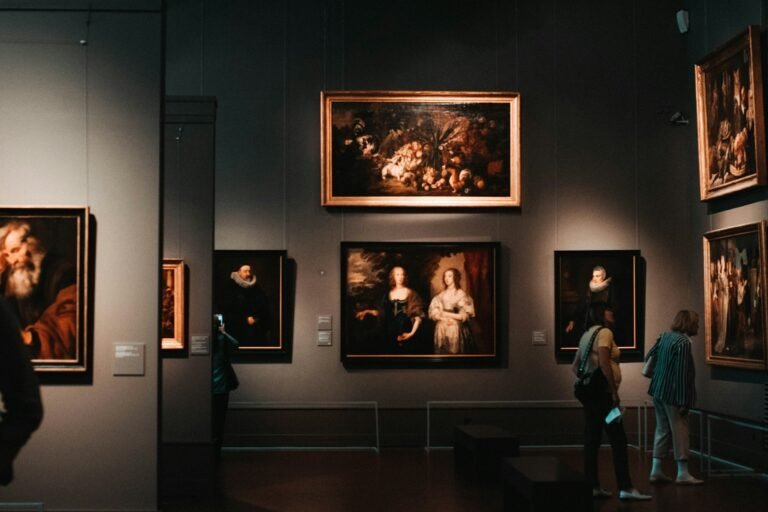Minimalist art painting, often simply referred to as Minimalism, is a movement in visual art that emerged in the late 1950s and gained momentum during the 1960s and 1970s. It is characterized by simplicity, the use of limited elements, a focus on pure form, and the elimination of personal expression. The movement was a response to the complexity and emotional intensity of Abstract Expressionism and sought to strip art down to its most fundamental features. Artists working in the minimalist style typically employ geometric shapes, monochromatic color palettes, repetition, and precise craftsmanship to evoke a contemplative, impersonal, and objective aesthetic. Minimalist art painting emphasizes the idea that “less is more,” inviting viewers to engage with the artwork in a direct, unmediated manner.
The origins of minimalist painting are deeply rooted in a range of artistic and philosophical developments that occurred in the 20th century. While the term “Minimalism” was not initially embraced by all of the artists associated with the movement, it has become a convenient way to describe a particular approach to making art that values clarity, restraint, and purity. Minimalism developed partially in reaction to the Abstract Expressionists like Jackson Pollock and Willem de Kooning, who emphasized gestural brushstrokes, emotional intensity, and individual subjectivity. Minimalist artists rejected this emotional excess and instead sought a more detached, impersonal approach. Influenced by the aesthetics of modernism, the Bauhaus movement, and the principles of Russian Constructivism, Minimalist artists explored the relationship between form, space, and viewer perception in a highly disciplined and formalized way.
One of the key principles of minimalist art painting is the emphasis on simplicity and reduction. Artists working in this style often limit themselves to a few basic forms or colors. This reduction is not merely about creating a sparse composition but about drawing attention to the essential characteristics of the painting itself—the canvas, the paint, the surface, and the interaction of light and space. Minimalist painters frequently avoid symbolism, narrative, or metaphor in favor of direct visual experience. The goal is to allow the viewer to engage with the work without distraction, to contemplate its presence and materiality. In this way, the minimalist painting becomes less about representation and more about the experience of perception.
The aesthetics of minimalist painting are often rooted in geometric abstraction. Artists like Frank Stella, Donald Judd (who later moved into sculpture), Agnes Martin, and Ellsworth Kelly created works that relied on the use of clean lines, precise shapes, and often a limited palette. Frank Stella’s early “Black Paintings,” for example, consist of symmetrical black stripes separated by thin lines of unpainted canvas. These paintings do not attempt to convey emotion or tell a story but instead present themselves as objects. Stella famously stated, “What you see is what you see,” a phrase that captures the essence of Minimalist philosophy. The painting does not reference anything outside itself; it is not a symbol or a window into another world, but a physical presence in the viewer’s space.
Agnes Martin’s minimalist works offer a subtle and meditative counterpoint to the more rigid geometry of her male counterparts. Her delicate grid paintings, composed of faint pencil lines and soft washes of color, reflect her interest in spirituality, serenity, and the search for inner harmony. While her works are minimalist in their simplicity and structure, they also evoke a quiet emotional depth. Martin’s art demonstrates how Minimalism can encompass a range of expressions within a shared formal language. Her approach illustrates that Minimalist painting is not necessarily devoid of feeling, but that emotion can be conveyed through restraint and subtlety.
Minimalist painters often employ monochromatic or limited color schemes to reinforce the sense of purity and reduce distractions. The use of a single color or tonal variations encourages the viewer to focus on texture, surface, and form rather than being seduced by visual complexity. This approach reflects the minimalist desire to remove the unnecessary and concentrate on the fundamental elements of painting. Artists like Ad Reinhardt pushed this to the extreme. His series of “black paintings,” which appear at first to be completely black, actually contain subtle variations of color and form that only reveal themselves upon prolonged viewing. These works challenge the viewer to slow down and pay close attention, promoting a contemplative engagement with the artwork.
The influence of Minimalist painting extended beyond the canvas. It aligned with broader cultural and intellectual trends of the 1960s, including developments in philosophy, music, and architecture. In philosophy, Minimalism found common ground with the ideas of phenomenology and structuralism, which emphasized the primacy of perception and the systems that govern experience. In music, composers like Steve Reich, Philip Glass, and La Monte Young explored repetition, simplicity, and gradual change—principles that resonate with minimalist art. In architecture and design, the minimalist ethos inspired the creation of clean, functional spaces that emphasized light, material, and proportion. The convergence of these disciplines highlights the ways in which Minimalism became more than a style; it was a way of thinking about the world and our place within it.
One of the defining characteristics of minimalist painting is its emphasis on objecthood. Unlike traditional paintings that serve as illusions or representations, minimalist works assert their physical presence as objects in space. This focus on objecthood was influenced by the ideas of the art critic and philosopher Clement Greenberg, who argued for the “medium specificity” of painting—that is, painting should emphasize qualities unique to its medium, such as flatness and color. However, many Minimalist artists went further, embracing a sculptural sensibility in their work. They were interested not just in the two-dimensional surface of the canvas but in the painting as a physical thing, occupying space and interacting with the viewer.
The minimalist approach to painting also involves a degree of rigor and discipline in the process of creation. Many minimalist artists adopt systems or rules to guide their work, removing the element of personal choice or spontaneity. Sol LeWitt, although more associated with conceptual art, exemplifies this approach. His wall drawings and instructions-based art emphasize the idea over the execution, reflecting a belief in the objective and impersonal nature of minimalist aesthetics. Similarly, Ellsworth Kelly’s use of chance and mathematics in determining the composition of his works reflects a desire to remove the artist’s hand and allow the form to arise through structure rather than intuition.
Despite its focus on simplicity, Minimalism has provoked a wide range of responses from critics and viewers. Some have celebrated its purity, clarity, and intellectual rigor, while others have dismissed it as cold, sterile, or elitist. Minimalist paintings often require a certain mindset and patience to be fully appreciated. They do not offer the instant gratification or visual drama of more expressive art forms. Instead, they invite the viewer to slow down, look closely, and engage with the subtleties of form, space, and perception. In a culture saturated with images and information, the minimalist painting offers a quiet space for contemplation and reflection.
Minimalism has also been criticized for its perceived exclusivity and its association with male dominance in the art world. Many of the most celebrated Minimalist artists—Donald Judd, Frank Stella, Carl Andre, and Dan Flavin—were men, and their work was often framed in terms of logic, objectivity, and authority. However, female artists like Agnes Martin, Jo Baer, and Anne Truitt brought a different sensibility to the minimalist project, demonstrating that the movement was not monolithic but capable of encompassing a range of perspectives. These artists challenged the notion that Minimalism was devoid of emotion or subjectivity, showing that simplicity could also be poetic, personal, and even spiritual.
In the decades since its emergence, Minimalist painting has continued to influence contemporary art. Many contemporary artists have adopted minimalist strategies in their work, whether as a continuation of the original movement or as a means of critique and reinterpretation. The legacy of Minimalism can be seen in the work of artists like Robert Ryman, who focused exclusively on white paintings that explored subtle variations of surface and texture; or in the practices of younger artists who use minimalist aesthetics to address issues of identity, politics, and technology. Minimalism’s emphasis on form, materiality, and perception remains relevant in a world increasingly shaped by digital media and virtual experiences.
Moreover, minimalist art has found a place in popular culture and design, influencing everything from fashion to user interfaces. The minimalist aesthetic—clean lines, neutral colors, open space—has become a dominant style in branding, advertising, and lifestyle trends. While this widespread adoption has sometimes diluted the conceptual rigor of Minimalist painting, it also speaks to the enduring appeal of simplicity and clarity in a complex world. The minimalist ethos continues to resonate with people seeking order, calm, and focus amid the chaos of modern life.
Minimalist painting also challenges traditional notions of beauty and craftsmanship. By emphasizing industrial materials, mechanical processes, and standardized forms, Minimalist artists redefined what a painting could be. They questioned the role of the artist as a solitary genius and opened up new possibilities for collaboration, process-based art, and conceptual inquiry. In doing so, Minimalism laid the groundwork for many of the developments in contemporary art, including installation, performance, and digital art. The minimalist approach to painting—its insistence on presence, materiality, and perception—has become a foundational paradigm in the ongoing exploration of what art can mean and how it can function in the world.
In conclusion, minimalist art painting represents a radical departure from traditional notions of artistic expression. Through its emphasis on simplicity, form, and objecthood, it challenges viewers to reconsider their relationship to art and the act of perception itself. Rooted in a desire to strip away the inessential and reveal the essence of painting, Minimalism offers a powerful counterpoint to the excess and spectacle of much contemporary culture. While it may appear austere or impersonal at first glance, minimalist painting rewards careful attention and thoughtful engagement. It invites us to slow down, to look deeply, and to find meaning in the quiet presence of form and color. As both a historical movement and a continuing influence, Minimalist painting remains a vital and thought-provoking force in the world of art.





























































































































































































































































































































































































































































































